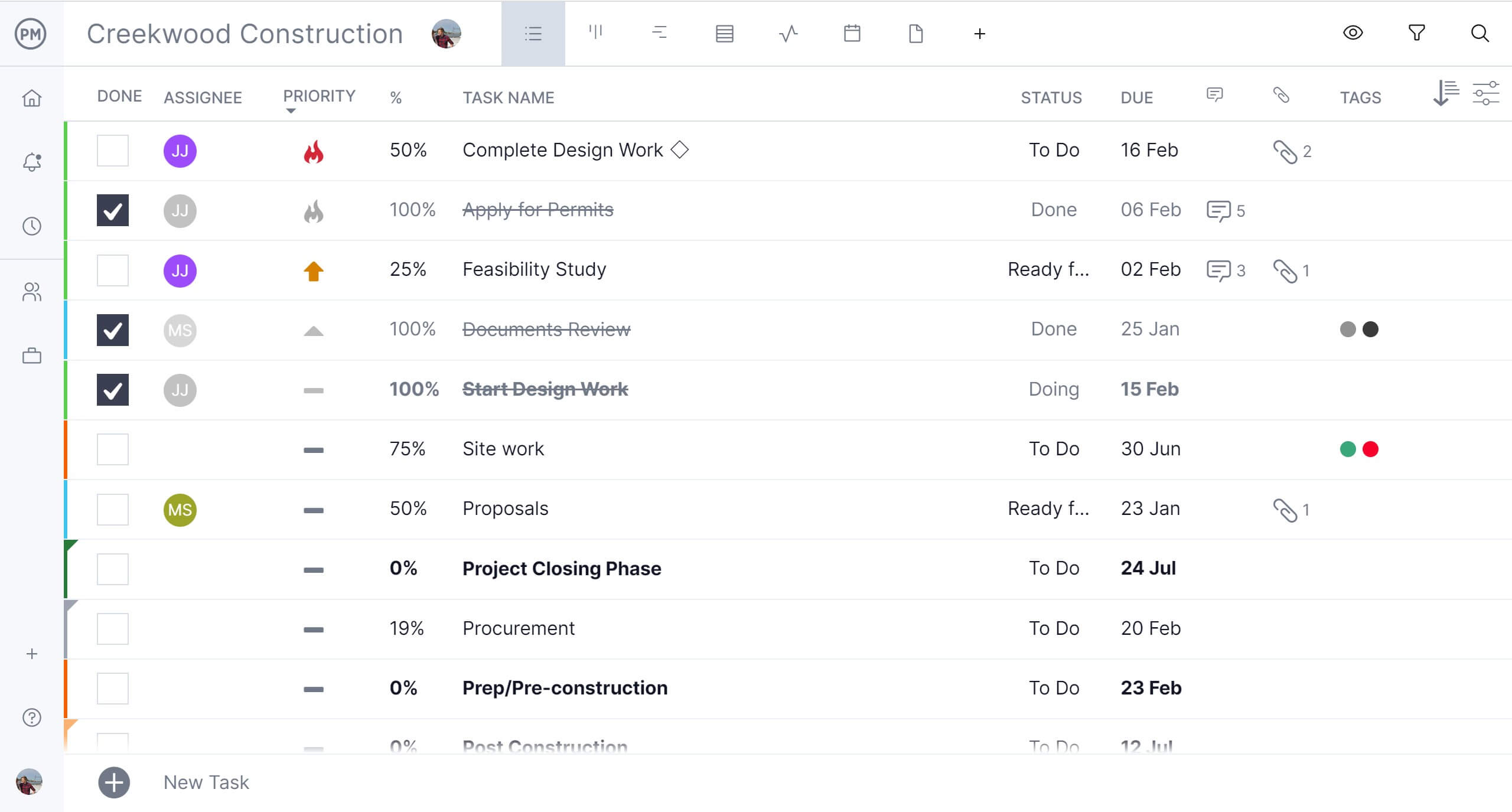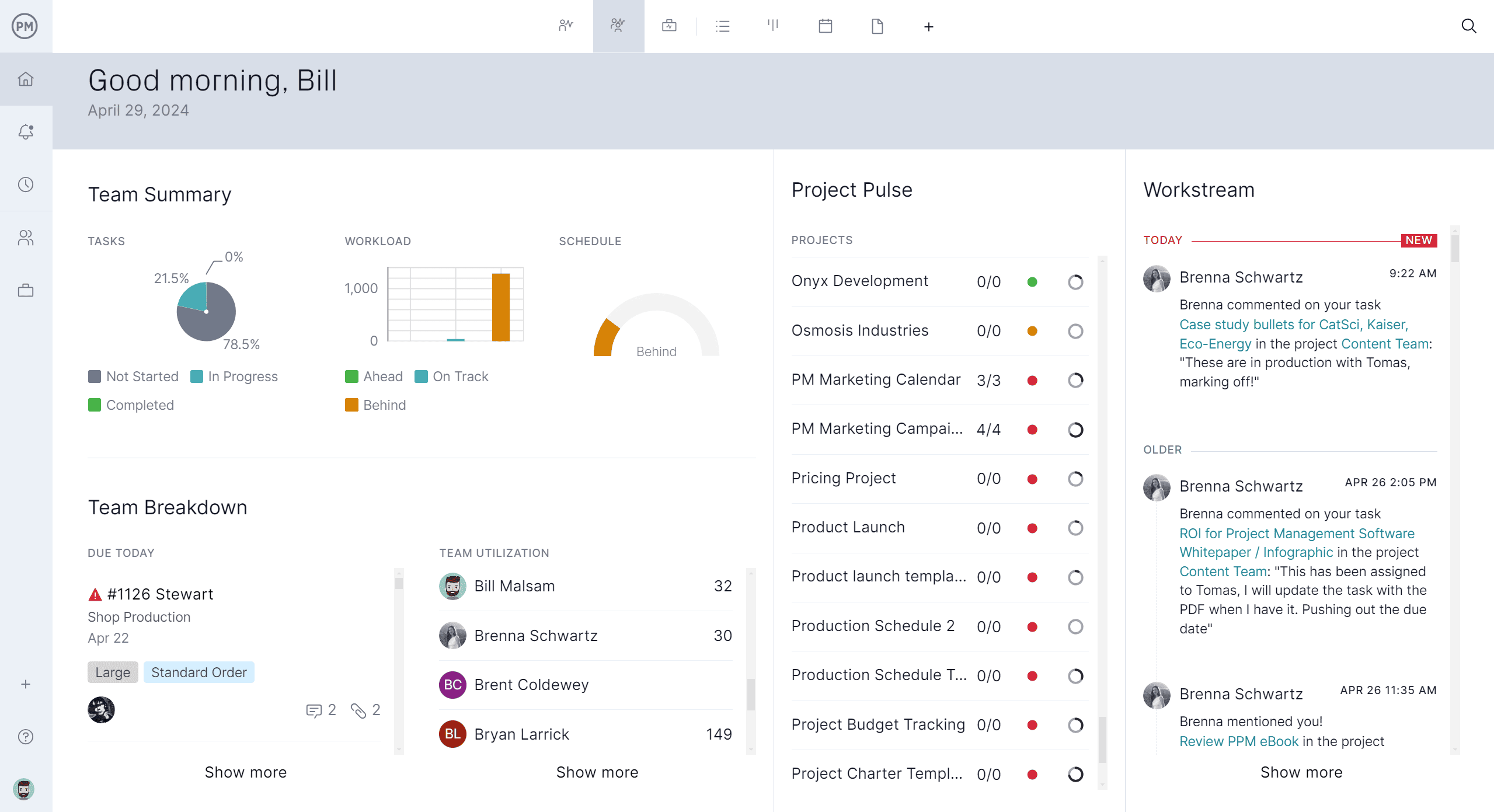When managing projects of any size, having clear and organized documentation is essential, and that’s where project report examples come into play. These reports serve as vital communication tools between project managers, stakeholders and team members, offering structured insights into different aspects of a project’s lifecycle. Whether you’re tracking progress, monitoring budgets, evaluating risks or reporting on feasibility, each report type serves a purpose to ensure informed decision-making and project success.
In this blog, we’ll walk through several essential project report examples, including a project status report example, project progress report example, project budget report example, project risk report example, project timesheet report example and project feasibility report example. These examples and formats will help you better understand what information to include, how to structure your reports, and how each type supports more efficient project tracking and delivery. Whether you’re new to project reporting or looking to refine your templates, these examples can serve as a practical guide.
1. Project Status Report Example
This project status report example for the Smart Campus Wi-Fi Upgrade illustrates the value of clear and structured communication in project management. The project report example presents an overview of the project’s current state, covering everything from accomplishments and deliverables to risks and budget health.
By including detailed sections—such as completed tasks, upcoming actions, milestone tracking and RAG (Red-Amber-Green) status indicators—stakeholders can quickly assess progress, spot potential delays (like the dorm installation), and make timely decisions. It’s particularly useful for keeping sponsors and senior management informed without digging through complex documentation.

The project report example’s importance lies in how it promotes accountability, aligns expectations and supports proactive risk management. For instance, flagging the dorm installation delay as “Amber” alerts decision-makers early, while highlighting green areas builds confidence in team performance.
Additionally, budget tracking, change logs and quality assurance offer a holistic view of the project’s health. This status report serves as a record and a decision-making tool, helping keep the project on schedule, within scope and on budget, which is critical in high-stakes infrastructure upgrades like campus-wide Wi-Fi improvements.
However, using a static Excel document to create a status report isn’t efficient. It’s better to upgrade to project management software. ProjectManager is award-winning project and portfolio management software with dynamic, real-time reports that automatically update with live project data.
No more entering figures, formatting charts and chasing down status updates in spreadsheets. Our customized reporting tools pull real-time data directly from ongoing tasks, time entries and resource usage across one or multiple projects. Get current and accurate reporting without the manual work. Get started with ProjectManager today for free.

2. Project Progress Report Example
A project progress report example like the one for the FutureTech Summit 2025 is crucial for maintaining transparency, accountability and momentum across teams and stakeholders. This project report example clearly outlines the status of major project components—such as scope, schedule, cost and risk—and compares them with the prior reporting period, offering a clear picture of how things are evolving.
For instance, while the overall project remains on time and within budget, the report flags a slight schedule delay due to weather and notes a moderate risk level increase caused by vendor issues. These insights help stakeholders quickly grasp where the project stands, what’s changed and where intervention may be needed.
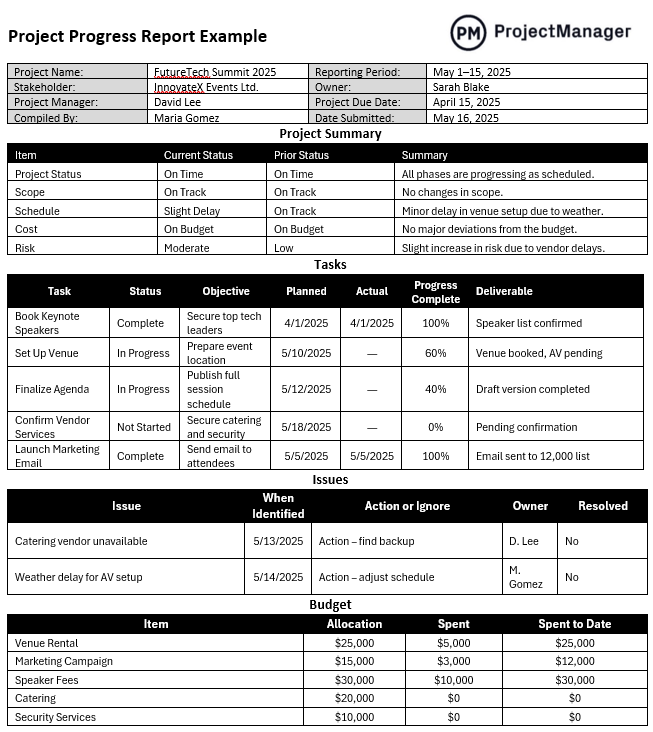
Beyond summary data, the report dives into specific task updates, highlighting planned versus actual timelines and percent completion, key for gauging execution efficiency. The project report example lists unresolved issues and budget utilization, offering full visibility into operational bottlenecks and resource allocation.
Including recent accomplishments and short-term goals provides context and keeps everyone aligned on next steps. For consultants, event planners and internal teams alike, progress reports like this one help ensure that projects not only stay on track but also adjust in real-time to risks and delays, boosting delivery success.
3. Project Budget Report Example
The project budget report example provides a detailed breakdown of planned versus actual costs across labor, materials, equipment and other cost categories. This format is essential for financial control and helps stakeholders understand how closely a project adheres to its budget.
The work breakdown structure (WBS) organizes the report, listing tasks like “Site inspection and clearance” or “Interior wall framing,” along with responsible team members, planned and actual work hours and hourly labor rates. The project report example reveals where overages occur, such as the significant $6,000 overrun in interior wall framing due to higher material and equipment costs than anticipated.

This kind of reporting is crucial for budget visibility and early intervention. The project report example highlights discrepancies like a $500 overage in site inspection or a $320 shortfall in electrical rough-in—insights that allow project managers to adjust spending or reallocate resources proactively.
The final column showing each task’s positive or negative balance is especially valuable for quick diagnostics. Overall, this report supports informed decision-making and prevents financial surprises by showing exactly where the project is tracking over or under budget—something static or high-level summaries often fail to capture with this level of precision.
4. Project Risk Report Example
The project risk report example offers a structured and proactive approach to identifying and managing potential project threats. Each risk is labeled with an ID (e.g., RIS001), described and evaluated for its potential impact, such as pushing back a product launch or causing cost overruns.
Accompanying each risk is a targeted response—like confirming delivery dates or assigning legal review—to mitigate its effect. This project report example also assigns ownership and categorizes the level of risk as high, medium or low, helping project managers prioritize which risks require immediate attention.
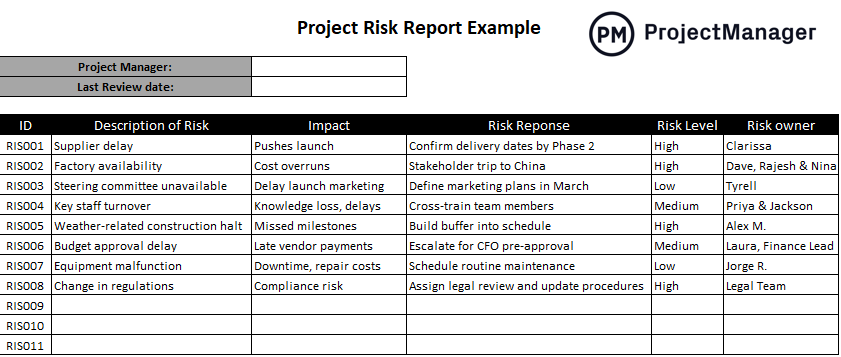
This kind of project report example is vital for keeping projects on track and stakeholders informed. For instance, risks like supplier delays and weather-related construction halts are flagged as high-level concerns with clear action plans in place. Ownership clarity—such as assigning the factory availability issue to Dave, Rajesh and Nina—ensures accountability.
Compared to more static or generic risk logs, this report goes further by tying risks to actionable responses and responsible parties, enabling teams to plan contingencies and adapt dynamically. It provides transparency and strategic foresight that can mean the difference between project success and failure.
5. Project Timesheet Report Example
The project timesheet report example for employee Oliver Jones in the marketing department offers a detailed snapshot of his work activity and compensation for a given period. Supervised by William Lasman, Oliver’s timesheet captures his dedication and work rhythm, showing entries for seven consecutive days.
His schedule varies slightly, sometimes starting early at 7:30 AM—as on Monday—or beginning later, such as 9:30 AM on Saturday, November 8, 2025. The project report example also tracks overtime meticulously, highlighting additional hours worked beyond his standard schedule, including 1.75 hours on Monday and 1.5 hours on Saturday.
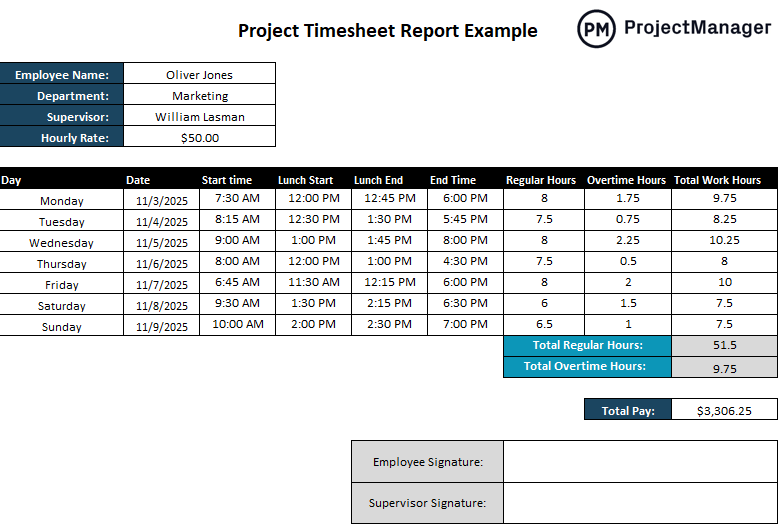
With a regular hourly rate of $50, Oliver logged 51.5 regular hours and 9.75 overtime hours, leading to a total pay of $3,306.25. This project report example not only calculates wages precisely but also provides visibility into workforce utilization, helping project managers and HR better understand staffing patterns, potential burnout and budget impact.
Compared to generic spreadsheets, a structured timesheet report like this ensures compliance, accurate payroll and clear accountability—especially valuable in fast-paced departments like marketing where schedules and workloads frequently shift.
6. Project Feasibility Report Example
The project feasibility report example comprehensively evaluates a proposed hotel development project in a prime urban location. This report begins by outlining the project description, goals and objectives, which include creating a luxury hospitality destination tailored to business and leisure travelers.
With amenities like conference facilities and premium dining, the hotel aims to capture a significant market share while supporting local economic growth. Key resource requirements—from land acquisition and labor to advanced technology and staffing—are also detailed to assess the scope of investment and logistics.
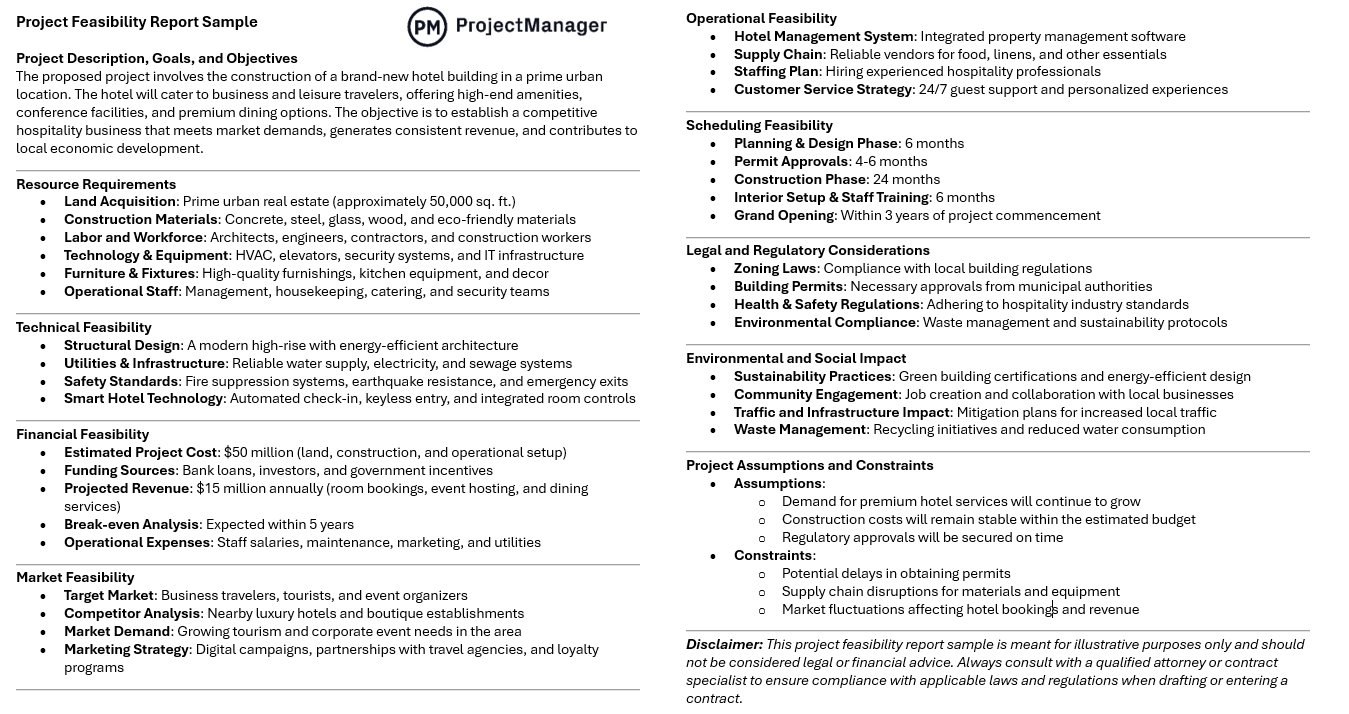
The report methodically covers critical feasibility areas: technical, financial, market, operational and scheduling feasibility. From green-certified structural design to integrated smart hotel systems, it affirms technical viability. A $50 million investment is forecast to break even in five years, with diversified funding sources and strong revenue projections. The market section confirms demand through competitor analysis and strategic marketing plans.
Operational and scheduling feasibility are well-documented with realistic timelines and system implementations. The project report example also addresses legal and environmental considerations, identifying sustainability practices and potential community impacts. Finally, it presents the assumptions and constraints that could affect project execution, making this example a model feasibility report for evaluating large-scale developments.
How ProjectManager Helps With Project Monitoring and Reporting
Rather than using project report examples, project managers and their teams can have greater transparency into their project’s performance and progress by upgrading to project management software. ProjectManager provides workload and availability tracking, letting managers see who is over- or underallocated on a color-coded workload chart. This visibility supports better decisions when assigning tasks or balancing capacity across teams. A team page shows daily or weekly team activity and can be filtered by progress or priority. Tasks can even be updated without leaving the page.
Get Progress Via Multiple Project Management Views
ProjectManager enhances project monitoring and reporting through its dynamic and integrated platform that offers multiple project views. Users can toggle between Gantt charts, kanban boards, task lists, sheets and calendars, allowing teams to visualize project progress from the perspective that best suits their workflow. These views always sync in real-time, giving stakeholders a clear and consistent understanding of task status, deadlines and dependencies across projects.

See Real-Time Data Across Teams and Tasks
Get a high-level, instant, visual summary of key performance indicators such as progress, task completion, team workload, budget consumption and time logged by toggling over to the real-time project or portfolio dashboards. Each dashboard is customizable, pulling live data from all active projects to help project managers quickly spot issues, track milestones and make informed decisions without digging through spreadsheets or static reports. The image below, for example, is the team summary dashboard that provides insights into how teams are utilizing their time.
Use secure timesheets to simplify time tracking and resource management. Team members can log hours anywhere, anytime and those entries automatically update the dashboards and reports. This enables managers to monitor actual effort versus planned time, identify productivity trends, control labor costs and ensure accurate client billing or internal accounting.

Related Content
These project report examples only scratch the surface of the subject matter. To go further into the topic, check out these links, which lead to articles with more free templates, explain a budget report in greater detail and much more.
- 12 Free Report Templates
- 15 Essential Excel Report Templates
- 15 Must-Have Business Report Templates
- 10 Free Project Report Templates for Excel & Word
- What Is a Budget Report? Purpose, Components & Benefits
- What to Include In a Construction Daily Report
- Work in Progress (WIP) Report in Construction
- Feasibility Report in Project Management
ProjectManager is online project and portfolio management software that connects teams whether they’re in the office or out in the field. They can share files, comment at the task level and stay updated with email and in-app notifications. Join teams at Avis, Nestle and Siemens who use our software to deliver successful projects. Get started with ProjectManager today for free.

